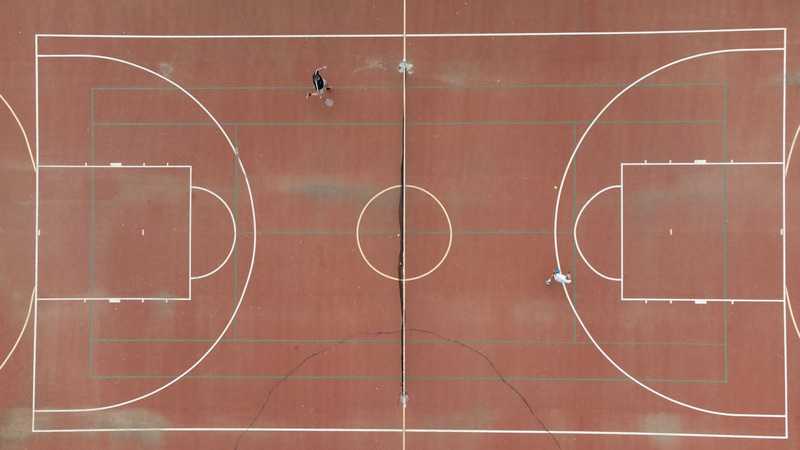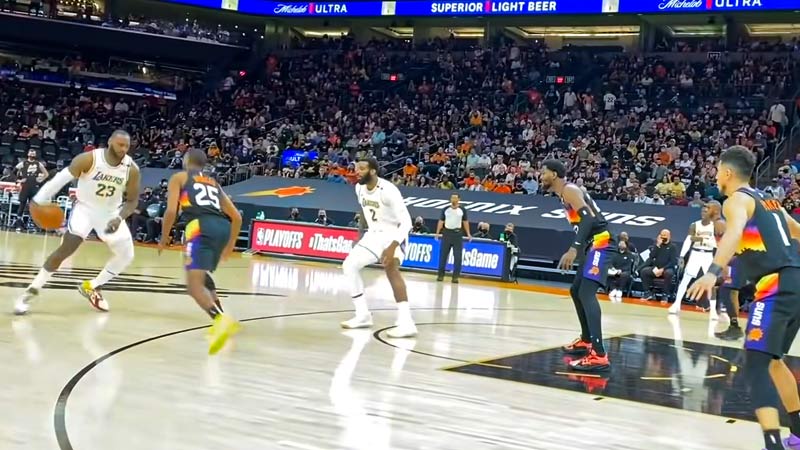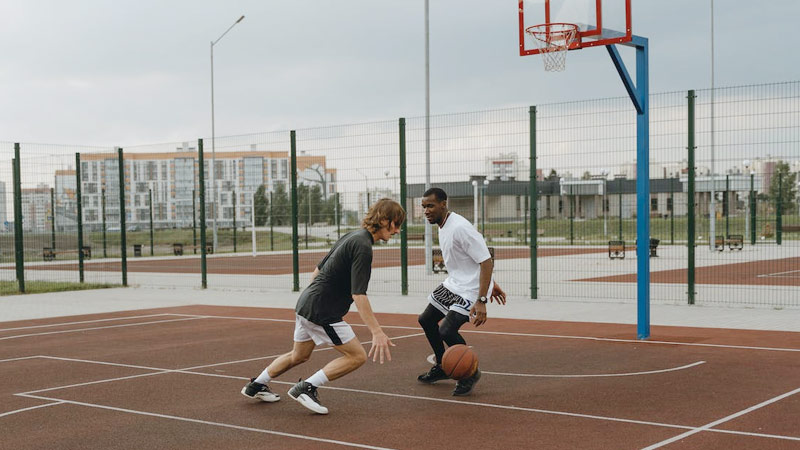The Basketball Court is the surface where tournaments and regular Basketball games take place. Without the court, it’s impossible to think of starting the play.
Be it in a confined stadium or an open field, the court will be there. In an open field, authorities will draw the lines to make the court visible.
Before you have such a task on hand, be sure to know about the court.
Basketball Court is divided into two parts – Front Court and Back Court. However, you should start with the front court because it has different meanings in basketball.
Keep reading to know all about the front court in basketball today.
Definition of Terms:
Get familiar with specific basketball terms to read our article seamlessly.
Mid Court Line: It’s the boundary line that divides the basketball court in two; also known as the half-court line or the center line. The Mid Court Line runs horizontally across the court and intersects the sideline at its midpoint.
Shot Clock: A timing device with a countdown upon which the team with the ball must attempt a goal. It starts at 24 seconds. For any interference, it shall reset to 14 seconds (According to Rule 7)
Dribble: It is the most move in basketball when one player moves by bouncing the ball from one place on the court to another. The dribbling ends when the player touches the ball simultaneously with both hands.
Step-Back Move: It’s a clever move where players create openings for their shots. Someone who is performing dribbling – side onto the basket, then suddenly moves away from the basket to create the space.
Jump Shot: When a player attempts to score by jumping into the free air, it is a jump shot. However, there are certain physical postures that a player must follow. Learn more about Jump Shot here.
What is The Front Court in Basketball?
The frontcourt is a relative term for each team in basketball. It’s like – when the offensive is present in their front court, it would be the backcourt of the defensive team. Other names of the front court are – the offensive end or the half-court.
It is the area in basketball that starts from the midcourt line to the baseline. Known as the offensive end because this part includes one or more players from the offensive team.
The opposing team guards the front-court basket and members of the offensive team use the front-court to score points by throwing the ball to the basket.
Talking about different meanings, the front court is also used in terms of basketball positions. Many professionals sometimes refer to small forward, power forward, and center as the front court.
Are the front court and back court identical? What’s the difference?
You may wonder what’s the catch point between the front court and the backcourt. The two are identical but it’s the viewpoint that makes all the differences.
The front court generally refers to the forwards and center. Upfront players remain closer to the basket in the front court.
On the other hand, the backcourt mainly plays the guarding role. Players play closer to the midfield and genuinely face the basket.
Other factors that separate the front court from the backcourt are location and the position of the ball.
Basketball Rules for Front Court and Back Court

Since the front court and back court both are identical in visibility, are rules the same for both teams? Here comes the twist.
Teams playing in these courts are opposing each other. Hence the rules are also different for them. Check them out:
1) The Ball Can’t Leave the Front Court
After completing a throw-in when a team proceeds to the front court, without a penalty, the ball may not leave the offensive end – the front court.
But if the ball bounces to the backcourt and an opposing player bats or taps the ball there, there will be no penalty.
Unlike Soccer or Hockey, in basketball, players are not allowed to skip the defensive pressure and retreat in the backcourt. The show must go forward.
This is one of the reasons why Basketball is popular among its fans and considered fast with high-scoring opportunities.
2) Offensive Team Loses the Ball
The offensive will lose control of the ball and a backcourt violation will be claimed. This will happen when any player from the offensive team proceeds with the ball to the frontcourt and then, without any prior reason, crosses back to the backcourt.
3) Players Must Meet the Allocated Time
National Basketball Associated confirmed 8 seconds to reach the front court. Although previously, it was 10 seconds later reduced at the beginning of the 2002 seasons.
However, this allocated time may vary from 20 to 30 seconds based on different leagues.
When the offensive team fails to enter the front court with the ball within this allocated time, they will lose custody of the ball.
Through this, the defensive team gets the privilege during the last few minutes of play in the fourth quarter.
With 8 seconds limit, the offense will be in a rush and take risks to pass the ball. This results in a high possibility of loose possession of the ball.
4) The 10 Seconds Rule
No team in their half of the court can possess the ball for more than 10 seconds to develop the rapid excitement of the game. However, when a team fails to pass the ball to the other half within 10 seconds, they will lose the ball.
The opponent team then gets the ball to shoot at bounds.
It is a standard rule for different organizations. From National College Athletic Association (NCAA) to Junior/ High School and Women’s Basketball, 10 seconds rule is followed seamlessly.
However, the violation of this rule may result in 10 seconds reward to the opposing team. This happens based on either of these scenarios – (1) The defense punches or kicks the ball (2) A defensive player records a technical foul (3) defense delays and the game is reset to 10 seconds.
The rules are simple and universal for both front-court and back-court players. Ensure not to violate them to maintain a peaceful harmony in the game.
In the next part, we will learn what are the specific actions offensive players can take in the front court. Read more to learn more.
Actions Offensive Team Can Take in The Front Court

Offensive players in the frontcourt can have one or more offensive rebounds. It can result in the opportunity to second score points.
However, in the front court, they can perform a set of actions including – dribbling, passing, cutting, screening, and shooting. Description below.
1) Dribbling the Ball
There are different kinds of dribbling moves in basketball. In the frontcourt, offensive players can perform any of the dribbling moves –
The Crossover Dribble: It is the standard dribbling procedure where the offensive player dribbles the ball with one hand on the way to the close area in front of them. He will also receive the ball using his other hand.
Between the Legs Dribble: It is another kind of dribbling when an offensive player genuinely dribbles the ball with one hand and passes it with another hand using the space between their legs.
Behind the Back Dribble: In this form of dribble, the offensive player uses the space behind them to dribble the ball. He dribbles with one hand and passes the ball using the area behind him to his other hand.
That’s not the end. Offensive players can use these moves in combination to attack the rim and create more opportunities for points.
Furthermore, they are also allowed to use dribbling moves with the step-back move and get open jump shots from the mid-range point or behind the three-point line.
2) Passing the Ball
In the frontcourt, the offensive players can pass the ball in a set of ways. They are Basic Chest Pass, Bounce Pass, or the Overhead Pass. Here’s a description below:
Chest Pass: It’s a chest-to-chest ball passing Happens when a player with the ball passes the ball, using both hands, from his own chest area targeting the chest area of the other player.
Bounce Pass: In this move, the player uses a specific amount of force to throw the ball at a certain angle to the floor and throws the ball to his teammate. He preferably uses his waist or chest area while throwing the ball.
Overhead Pass: The player holds the ball over his head before throwing it. He is advised to use both hands while throwing the ball so that the trajectory of the ball leads to a direct path to the player who is about to receive it.
However, offensive players are not limited to these passing moves only. They can use the drift pass, lob pass, or skip pass also for certain scenarios when they are proven to be more effective to score points.
3) Cutting the Way
A cut occurs in basketball when an offensive player who doesn’t own the ball moves from one part of the court to another with certain moves. His primary goal is to create scopes to get an opening from the defender.
In the frontcourt, offensive players can use different basketball cuts near the basket to create scoring opportunities.
Some of the basketball cuts include the backdoor cut, the Iverson cut, the laker cut, the split cut, the V-cut, and the zipper cut.
4) Basketball Ball Screening
Also known as a basketball screen or a pick, is a popular move in the play. Offensive players can execute this move in the front court.
In this move, a player places their body in front of a defender where his teammate gets the scope to shoot and throw at the basket.
Different Basketball Screen exists, such as the back screen, the cross screen, the down screen, the drag screen, the elevator screen, the flare screen, the ram screen, the stagger screen, and some others.
An offensive player can use any of the picks mentioned above within the front court. However, keep in mind that, no contact should occur while setting the screening act.
Players need to maintain a sufficient amount of distance from the opponent. Otherwise, it will be an illegal screening and will result in a turnover for the offensive team.
5) Shooting the Ball
It is what we all know about! While the ball is in the front court status, offensive players have to attempt to throw the ball in the basket. They can try out a variety of shots from the front court.
However, how you take attempts will vary depending on your position on the half-court. For example, perimeter players such as the point guard, the shooting guard, and small forward players are suitable for the layup, the floater, the mid-range, and the three-point jump shot.
There are also some other shooting styles for the post players (power players and center players) like – the post fadeaway, the up and under move, the drop step, including the face-up jump shot.
Additionally, offensive players can also perform offensive rebounds in the front court. It brings exclusive results when defenders look up at the rim during a throw without a proper box out.
Any Last Words?
While there are a lot of things to learn about Basketball, you should start with the basics. It is important to build a powerful base to explore the details of basketball freely.
The Basketball Court is the vital surface to begin the game. Thus, we advise you to learn the details, and limitations of players within this area.
Since it has two parts in regulation, we need to learn them differently for better understanding.
Note that, basketball is an interesting sport. To some point, its popularity has surpassed other traditional sports like baseball or hockey.
Thus, if you want to build a career in basketball and take it as more than a form of entertainment, it is time to get yourself educated on the ins and outs of basketball. And we are here with you on this journey.







